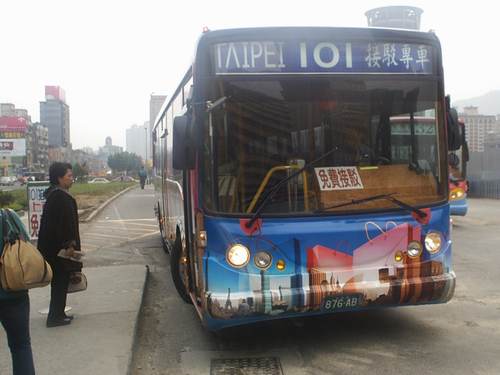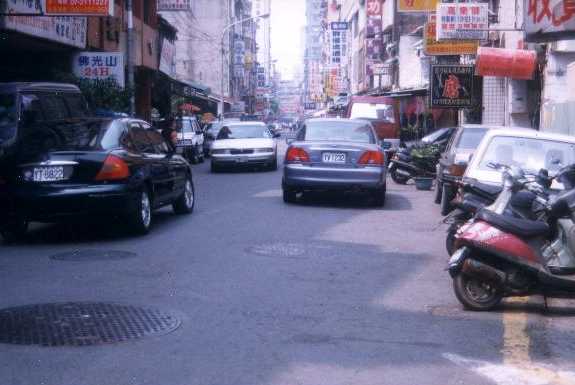Michael A. Turton
 The
free bus that ran to Taipei 101.
The
free bus that ran to Taipei 101.Transportation:
Getting Around in the Cities
|
Michael A. Turton |
 The
free bus that ran to Taipei 101. The
free bus that ran to Taipei 101. |
|
Transportation: |
|
| Taiwan's transportation net has become strained in the last ten years, though new roads are constantly coming on line. Consequently, getting around in Taiwan is easy but time-consuming. |
| Buses and taxis are reliable and plentiful in
Taipei and
bus guides are available in English for Taipei at the major English
bookstores.
Taxis are found everywhere throughout the island, but naturally are easiest to find in the big cities. |
| There are plenty of intercity buses, but the rest of the island is not well-provided with local transportation facilities, a situation which has strained relations between Taipei and the other cities. Taichung has only a few city buses that run only to a handful of major destinations, and Kaohsiung is even worse. |
| In Taipei you can pick up intercity buses down by the train station. In Taichung you can get them on Taichungkang Rd near the highway, and on Chungching Rd near the Daya highway exit. In Kaohsiung, you can get intercity buses near the train station, and near the Chienkuo Rd. highway interchange. |
| All the major cities have intercity buses, but the minor satellite cities such as Fengshan or Fengyuan do not. Most intercity buses run every half hour, and seats are sold on a first-come-first-served basis. The cost of a typical Taichung to Taipei run is between $250 and $350, depending on which line you take. |
| City buses run on a simple system. Watch the other riders. In some areas you pay as you get on, in others, as you get off. If you travel through two areas, you will have to pay as you get on, and again as you get off. |
| The train system is good, but packed. There is a
system
of express trains that connects the cities, while slow trains link the
towns. Purchasing tickets is a godawful pain due to high demand on
weekends,
so have a Taiwanese friend or the secretary at your school do it for
you.
Weekdays the trains are empty and you can get tickets at the counter.
Taiwan also has a high speed rail system, like Japan, but tickets are
pricey. |
| It is easy to get hold of motorcycles and scooters, as well as to rent or purchase cars. A new 50cc motorcycle costs between $28,000 and $35,000. Used motorcycles are available everywhere. Check bulletin boards where foreigners hang out. Also, the people at your school can help you find one too. |
| Important: It
is painfully
difficult to live outside of Taipei without a motorcycle or a car. Most
foreigners here for any length of time get a scooter if they live
outside
of Taipei (licenses are necessary for scooters over 50cc, although many
foreigners ignore the rules and drive without a license). |
| We own an electric scooter. Although good for short trips, its limited range makes it useless as a vehicle for English teachers riding from one part of the city to another on jobs. Sad though it may seem, stick to gasoline power for the foreseeable future. |
| The downside of motorcycles and scooters is that
they
are unsafe. Accidents are inevitable and merely a question of
time.
Everyone I know has had accidents on their scooters, including this
writer.
Fortunately due to the low speeds caused by high traffic densities, most are minor. Because of the mad traffic of Taipei you are better off using the wonderful public transportation system.
|
 Cars jockey for position on a crowded side street in
downtown
Kaohsiung.
The dearth of defined parking, the routine lack of law enforcement, the
indifference of Taiwanese to the needs of others and the reluctance of
the government to clamp down on the size and quantity of vehicles makes
for anarchy. Cars jockey for position on a crowded side street in
downtown
Kaohsiung.
The dearth of defined parking, the routine lack of law enforcement, the
indifference of Taiwanese to the needs of others and the reluctance of
the government to clamp down on the size and quantity of vehicles makes
for anarchy. |
| If you get ripped off by a taxi, there isn't anything you can do about it. However, you can minimize the possibility of taxi rip-offs by picking drivers from particular companies. Look at the driver. If he or she is well-dressed or in a uniform, chances are he works for a company that enforces driver discipline. Get his business card or his company phone number, and call them when you need a ride. This is especially useful in smaller towns. My wife is a frequent taker of taxis, and we always use the same three drivers (this year the company had an internal struggle over her business and changed its districts to accommodate demands that she take other drivers!). The business is competitive, and they will be happy to get your business on a reliable basis. |
| Tip:Outside of Taipei it is frequently possible to get the taxi driver to turn the meter off. You can then bargain down the price of the drive to an agreed-upon cost. Of course, you have to know the actual cost of driving from your location to your destination! |
| TIP: Do
not take taxis from in front of the various train and bus stations,
especially
if the meter is turned off. In that case, there will almost certainly
be
an overcharge of at least 30-50%. It is best to walk out of the
train
or bus station a block or so and pick up a taxi passing by on the
street.
Take only metered taxis in unfamiliar areas.
|
| Biking is a sane alternative in the cities. In heavy traffic bikes are faster than any other vehicle, and even in light traffic they are faster than a bus. I recommend helmets and masks if you bike in the cities. |  A friend takes a break on a bike ride down the east coast. A friend takes a break on a bike ride down the east coast. |
| Taiwan is a world leader in bike manufacturing and high-quality bikes are cheap and plentiful across the island, as are places to get them repaired. Many locals and foreigners take extended bike trips around the island. |